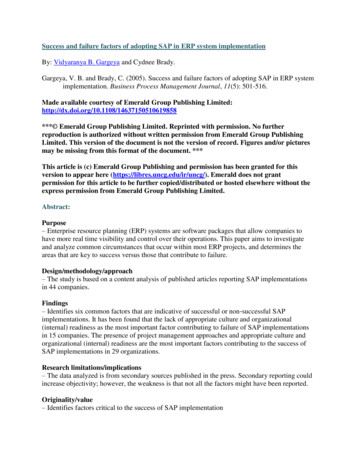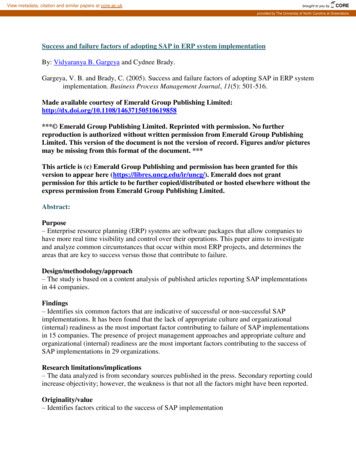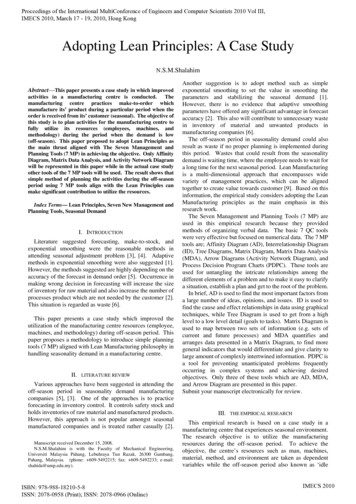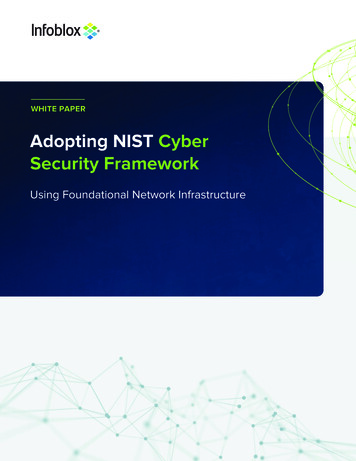
Transcription
Opportunities & Challenges in Adopting MicroserviceArchitecture for Enterprise WorkloadsShriram Rajagopalan,Priya Nagpurkar, Tamar Eilam,and Hani JamjoomIBM Watson ResearchEtai Lev-Ran, andVita BortnikovFrank BudinskyIBM Research, HaifaIBMContact: shriram@us.ibm.com
Emergence of microservices & DevOps Challenges & Opportunities Adopting a SDN perspective of microservices Version/Content-aware routing Systematic resilience testing2
Emergence of microservices & DevOps Challenges & Opportunities Adopting a SDN perspective of microservices Version/Content-aware routing Systematic resilience testing3
From Monoliths to MicroservicesMonolithic ServiceinstancesMicroserviceinstancesWell-defined API A single service serves multiplepurposes Each service serves a singlepurpose (functionality) Tight-coupling across services Many loosely-coupledmicroservices communicateover the network4
From Waterfall to DevOpsmonths to tures, performance improvements,bug fixes, etc., are periodically deliveredas one big updateCulture Automation Instrumentationhoursto daysPDTDPDTDPDTDPDTDPDTDContinuous delivery of incremental updatesEmphasizes constant experimentation &feedback-driven development5
Microservices aGoDBNoSQLFRDBMSCloud Platform ServicesSocial MediaPolyglot applications withloosely-coupled microservices Small “two pizza” teams permicroserviceMobile PushNotification– Autonomy & accountability– Own the roadmap for thefeature/service– Independent launch schedules D’MessageBus3 rd partyInternet Services Develop, deploy, scale – “You build it, you run it” 10s to 100s of deployments aday across the application– E.g., Orbitz, GrubHub, HubSpot Multiple versions co-existsimultaneously6
“Traditional” Enterprises are moving or have movedto Microservices DevOps7
Emergence of microservices & DevOps Challenges & Opportunities Adopting a SDN perspective of microservices Version/Content-aware routing Systematic resilience testing8
Opportunities Enterprises are– Re-architecting legacy applications to microservice architecture– Developing in-house platforms to host sensitive apps on premise E.g. Fidelity’s Mako– Still experimenting with different design alternatives– Heavily leveraging open-source technologies Opportunity for the research community to engage– Influence infrastructure & application design– Integrate ideas into open-source platforms and solutions9
sFGoDBNoSQLRDBMSMessageBusCloud Platform Services 10s to 100s of deployments a dayacross the application Multiple versions co-existsimultaneously3 rd partyInternet ServicesFacebookMobile PushNotification D’ Complexity shifted to the networkand orchestration across services Cascading failures despite themicroservices being designed forfailure10
Ad-hoc Designs & Implementations Two Options: Adopt open-source frameworks from large scale internetapplications (e.g., Netflix OSS) These frameworks are point solutions that fit the needs & environment ofthe companies that operate these applications (e.g., Java only support) Shoehorn the service-oriented web application into clusteringframeworks like Kubernetes, Marathon, etc., and write ad-hoc toolson top to control the microservices11
Emergence of microservices & DevOps Challenges & Opportunities Adopting a SDN perspective of microservices Version/Content-aware routing Systematic resilience testing12
Microservice Application Requirements Integration– Service registration & discovery– Load balancing of requests across microservice instances Version & content-aware routing––––Hypothesis driven-development (i.e. A/B testing)Canary deployments (feature release to % of users)Red/Black deployments (gradual rollout to all users)Etc. Operational testing in production– E.g., does failure recovery work as expected?13
Introducing Amalgam8 Observation:– Microservices interact only over the network predominantly using HTTP(s)– Existing solutions lack the ability to dynamically control the routing ofrequests between two microservices Insight:– Think of requests as packets and microservices as switches– A Layer-7 SDN will simplify integration and routing Design:– Sidecar: A programmable layer-7 proxy process attached to each microservice– Controller: The equivalent of an SDN controller, except at Layer-714
Simplifying IntegrationAPIMulti-tenantControl PlaneData Plane w/Tenant AppsController, Service RegistryB’A'Tenant 2CRequestsABTenant 3Tenant 1SidecarKubernetes, Marathon, Swarm, VMs, Bare Metal 15
Emergence of microservices & DevOps Challenges & Opportunities Adopting a SDN perspective of microservices Version/Content-aware routing Systematic resilience testing16
AnalyticsAuto-rollback if B’ fares poorly comparedto B, with a given confidence measureRef. to Canary Advisor, ISSTA 2015Active Deploy CanarydeploymentsRed/BlackdeploySend 35% of iphonetraffic to A’ and 65% to Aupgrade from B to B’VersionRoutingMulti-tenantControl PlaneData Plane w/Tenant AppsAPIController, RegistryB’A'Tenant 2CRequestsABTenant 3Tenant 1SidecarKubernetes, Marathon, Swarm, VMs, Bare Metal 17
Emergence of microservices & DevOps Challenges & Opportunities Adopting a SDN perspective of microservices Version/Content-aware routing Systematic resilience testing18
Resilience Testing Microservices designed but “seldom” tested for failures Randomized fault injection (e.g., Netflix Chaos Monkey) is insufficient– Manual effort to validate whether application recovered properly or not Gremlin – systematic resilience testing––––Script failure scenarios and expectationsFaults injected from the networkRun assertions on the logs to validate expectationsExposes faulty recovery behavior, conflicting failure handling policies acrossservices, etc.19
Ref. to Gremlin, ICDCS 2016Failures are emulated by manipulatingnetwork interactions between services(e.g., delays, HTTP 500s, etc.)GremlinResilience TestingAssertions are validated against request logsto identify faulty recovery behaviorVersionRoutingMulti-tenantControl PlaneData Plane w/Tenant AppsOverload(C)Assert (A’ responds in 10ms)APIFaultInjectionController, RegistryB’A'Tenant 2CRequestsABTenant 3Tenant 1SidecarKubernetes, Marathon, Swarm, VMs, Bare Metal 20
Thank You https://amalgam8.io https://github.com/amalgam8/examples21
Backup22
Research Challenges in the Face of ContinuousChange Managing stateful services and data stores Problem determination gains many dimensions– The problem may not just be in your code– Many dimensions change simultaneously such as infrastructure, runtime, etc.– Can we pinpoint the issue down to the Git commit by correlating runtime logsand development history? Too much data, too little insights– Logs emitted by all layers of the software stack, by automated build tools, etc.– Yet, we are no where close to pinpointing the problem and fixing it whenthings go wrong!23
Opportunities to Fix Issues Before They Occur Software build, test and deployment phases are completelyautomated Provides a unique opportunity to catch security vulnerabilities,buggy implementations, etc., even before software is deployed However, existing tools and techniques do not scale to the extremecode churn (100s of deployments)24
Architecture for Enterprise Workloads Shriram Rajagopalan, Priya Nagpurkar, Tamar Eilam, and Hani Jamjoom Etai Lev-Ran, and Vita Bortnikov IBM Watson Research IBM Research, Haifa Frank Budinsky IBM Contact: shriram@us.ibm.com Emergence of microservices & DevOps Challenges & Opportunities . Bus NoSQL Cloud Platform Services .










